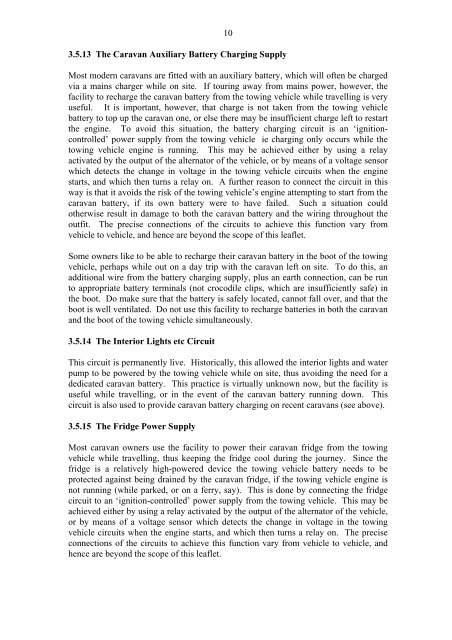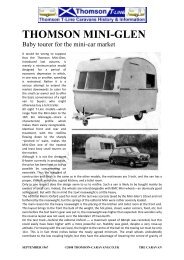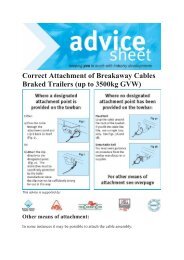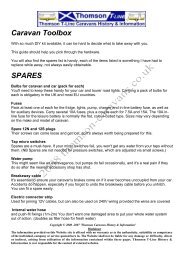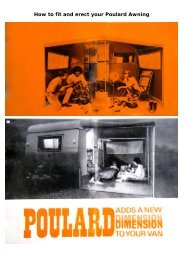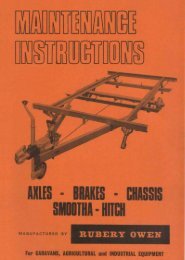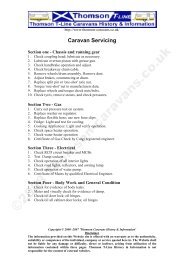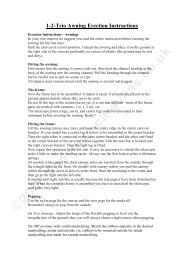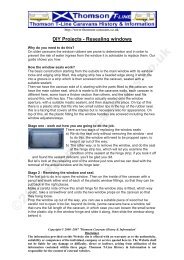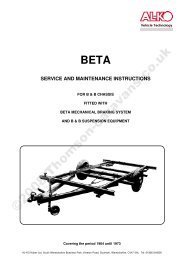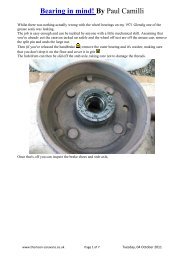Towbar Wiring - Volvo Owners Club
Towbar Wiring - Volvo Owners Club
Towbar Wiring - Volvo Owners Club
You also want an ePaper? Increase the reach of your titles
YUMPU automatically turns print PDFs into web optimized ePapers that Google loves.
10<br />
3.5.13 The Caravan Auxiliary Battery Charging Supply<br />
Most modern caravans are fitted with an auxiliary battery, which will often be charged<br />
via a mains charger while on site. If touring away from mains power, however, the<br />
facility to recharge the caravan battery from the towing vehicle while travelling is very<br />
useful. It is important, however, that charge is not taken from the towing vehicle<br />
battery to top up the caravan one, or else there may be insufficient charge left to restart<br />
the engine. To avoid this situation, the battery charging circuit is an ‘ignitioncontrolled’<br />
power supply from the towing vehicle ie charging only occurs while the<br />
towing vehicle engine is running. This may be achieved either by using a relay<br />
activated by the output of the alternator of the vehicle, or by means of a voltage sensor<br />
which detects the change in voltage in the towing vehicle circuits when the engine<br />
starts, and which then turns a relay on. A further reason to connect the circuit in this<br />
way is that it avoids the risk of the towing vehicle’s engine attempting to start from the<br />
caravan battery, if its own battery were to have failed. Such a situation could<br />
otherwise result in damage to both the caravan battery and the wiring throughout the<br />
outfit. The precise connections of the circuits to achieve this function vary from<br />
vehicle to vehicle, and hence are beyond the scope of this leaflet.<br />
Some owners like to be able to recharge their caravan battery in the boot of the towing<br />
vehicle, perhaps while out on a day trip with the caravan left on site. To do this, an<br />
additional wire from the battery charging supply, plus an earth connection, can be run<br />
to appropriate battery terminals (not crocodile clips, which are insufficiently safe) in<br />
the boot. Do make sure that the battery is safely located, cannot fall over, and that the<br />
boot is well ventilated. Do not use this facility to recharge batteries in both the caravan<br />
and the boot of the towing vehicle simultaneously.<br />
3.5.14 The Interior Lights etc Circuit<br />
This circuit is permanently live. Historically, this allowed the interior lights and water<br />
pump to be powered by the towing vehicle while on site, thus avoiding the need for a<br />
dedicated caravan battery. This practice is virtually unknown now, but the facility is<br />
useful while travelling, or in the event of the caravan battery running down. This<br />
circuit is also used to provide caravan battery charging on recent caravans (see above).<br />
3.5.15 The Fridge Power Supply<br />
Most caravan owners use the facility to power their caravan fridge from the towing<br />
vehicle while travelling, thus keeping the fridge cool during the journey. Since the<br />
fridge is a relatively high-powered device the towing vehicle battery needs to be<br />
protected against being drained by the caravan fridge, if the towing vehicle engine is<br />
not running (while parked, or on a ferry, say). This is done by connecting the fridge<br />
circuit to an ‘ignition-controlled’ power supply from the towing vehicle. This may be<br />
achieved either by using a relay activated by the output of the alternator of the vehicle,<br />
or by means of a voltage sensor which detects the change in voltage in the towing<br />
vehicle circuits when the engine starts, and which then turns a relay on. The precise<br />
connections of the circuits to achieve this function vary from vehicle to vehicle, and<br />
hence are beyond the scope of this leaflet.


